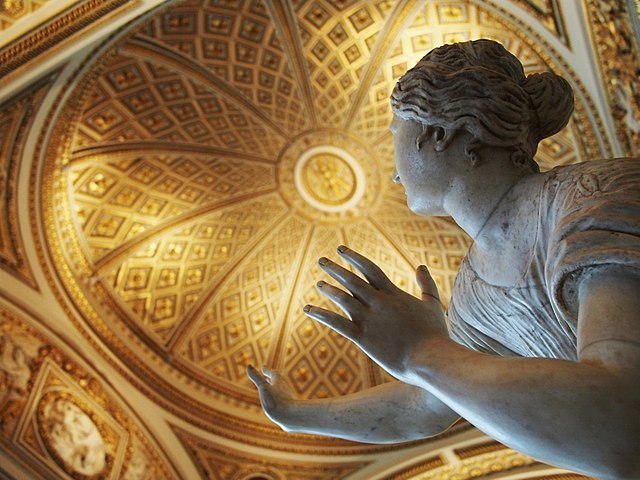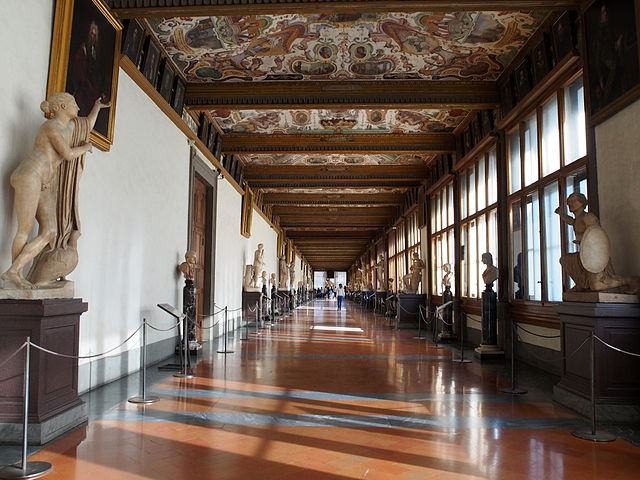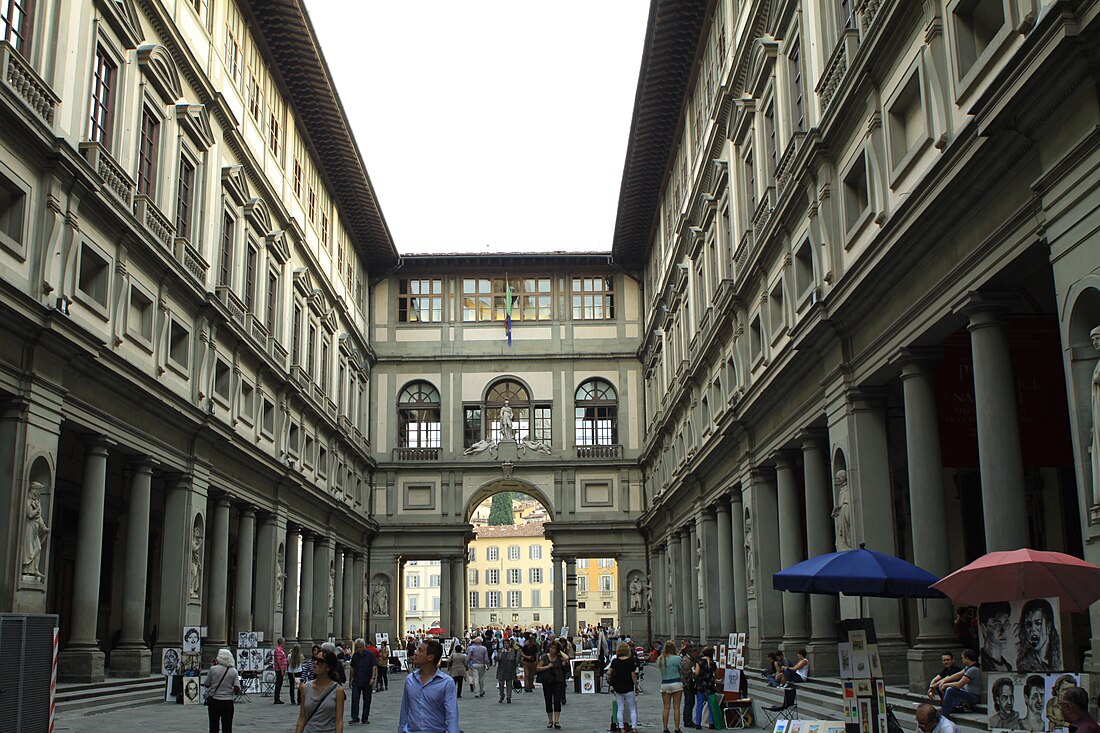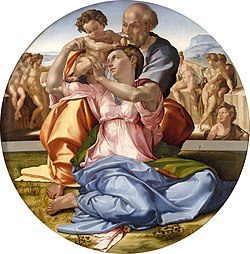Uffizi
Art museum in Florence, Italy From Wikipedia, the free encyclopedia
The Uffizi Gallery (UK: /juːˈfɪtsi, ʊˈfiːtsi/ yoo-FIT-see, uu-FEET-see;[2][3] Italian: Galleria degli Uffizi, pronounced [ɡalleˈriːa deʎʎ ufˈfittsi]) is a prominent art museum located adjacent to the Piazza della Signoria in the Historic Centre of Florence in the region of Tuscany, Italy. One of the most important Italian museums and the most visited, it is also one of the largest and best-known in the world and holds a collection of priceless works, particularly from the period of the Italian Renaissance.
Galleria degli Uffizi | |
 | |
 Narrow courtyard between the two wings of the museum, with view toward the Arno river | |
 Interactive fullscreen map | |
| Established | 1581 |
|---|---|
| Location | Piazzale degli Uffizi, 50122 Florence, Italy |
| Coordinates | 43°46′6″N 11°15′19″E |
| Type | Art museum, design/textile museum, historic site |
| Visitors | 4,957,978 (2023) |
| Director | Eike Schmidt[1] |
| Website | uffizi.it |


After the ruling House of Medici died out, their art collections were given to the city of Florence under the famous Patto di famiglia negotiated by Anna Maria Luisa, the last Medici heiress. The Uffizi is one of the first modern museums. The gallery had been open to visitors by request since the sixteenth century, and in 1769 it was officially opened to the public, formally becoming a museum in 1865.[4]
History
Summarize
Perspective

The building of the Uffizi complex was begun by Giorgio Vasari in 1560 for Cosimo I de' Medici as a means to consolidate his administrative control of the various committees, agencies, and guilds established in Florence's Republican past so as to accommodate them all in one place, hence the name uffizi, "offices". The construction was later continued by Alfonso Parigi and Bernardo Buontalenti; it was completed in 1581. The top floor was made into a gallery for the family and their guests and included their collection of Roman sculptures.[5]
The cortile (internal courtyard) is so long, narrow, and open to the Arno at its far end through a Doric screen that articulates the space without blocking it, that architectural historians[6] treat it as the first regularized streetscape of Europe. Vasari, a painter, and architect as well, emphasized its perspective length by adorning it with the matching facades' continuous roof cornices, and unbroken cornices between storeys, as well as the three continuous steps on which the museum fronts stand. The niches in the piers that alternate with columns of the Loggiato are filled with sculptures of famous artists in the 19th century.


The Uffizi brought together under one roof the administrative offices and the Archivio di Stato, the state archive. The project was intended to display prime artworks of the Medici collections on the piano nobile; the plan was carried out by his son, Grand Duke Francesco I. He commissioned the architect Buontalenti to design the Tribuna degli Uffizi that would display a series of masterpieces in one room, including jewels; it became a highly influential attraction of a Grand Tour. The octagonal room was completed in 1584.[7]
Over the years, more sections of the building were recruited to exhibit paintings and sculptures collected or commissioned by the Medici. For many years, 45 to 50 rooms were used to display paintings from the 13th to 18th century.[8]
Modern times
Summarize
Perspective
Because of its vast collection, some of the Uffizi's works have in the past been transferred to other museums in Florence—for example, some famous statues to the Bargello. A project was finished in 2006 to expand the museum's exhibition space some 6,000 metres2 (64,000 ft2) to almost 13,000 metres2 (139,000 ft2), allowing public viewing of many artworks that had usually been in storage.
The Nuovi Uffizi (New Uffizi) renovation project which started in 1989 was progressing well from 2015 to 2017.[9][10] It was intended to modernize all of the halls and more than double the display space. A new exit was also planned and the lighting, air conditioning and security systems were updated. During construction, the museum remained open, although rooms were closed as necessary with the artwork temporarily moved to another location.[11] For example, the Botticelli rooms and two others with early Renaissance paintings were closed for 15 months but reopened in October 2016.[12]
Over two million visitors visited the Uffizi in 2016, making it the most visited art gallery in Italy.[13] At peak periods (particularly in July), waiting times for entry can be up to five hours. Advance tickets can be bought online, to significantly reduce the waiting time.[8] In 2018 a revised ticketing system was introduced to reduce queuing times to just minutes.[14]
Due to the COVID-19 pandemic, the museum was closed for 150 days in 2020, and attendance plunged by 72 percent to 659,043. Nonetheless, the Uffizi was twenty-seventh in the list of most-visited art museums in the world in 2020.[15] Works from the Uffizi gallery collection are now available for remote viewing on Google Arts and Culture.[16] The museum reopened in May 2021 following a renovation that included an addition of 14 new rooms and a display of additional 129 artworks, with the museum attempting to give more voice to historically under-represented groups including women and people of color.[17]
Incidents
On 27 May 1993, the Sicilian Mafia carried out a car bomb explosion in Via dei Georgofili which damaged parts of the palace and killed five people. The blast destroyed five pieces of art and damaged another 30. Some of the paintings were fully protected by bulletproof glass.[18] The most severe damage was to the Niobe room and classical sculptures and neoclassical interior, which have since been restored, although its frescoes were damaged beyond repair.
On 22 July 2022, members of the climate activist group Ultima Generazione (Last Generation) glued themselves to the glass protecting Sandro Botticelli's Primavera demanding an end to fossil fuel usage. The painting was undamaged.[19]
On 13 February 2024, members of Ultima Generazione glued images of flooding in Tuscany in 2023 to the glass protecting Sandro Botticelli's Birth of Venus in protest over the Italian government's inaction on climate change. The painting was undamaged and the images were removed.[20]
Key works
Summarize
Perspective
- Cimabue: Santa Trinita Maestà
- Duccio: Rucellai Madonna
- Giotto: Ognissanti Madonna, Badia Polyptych
- Simone Martini: Annunciation with St. Margaret and St. Ansanus
- Ambrogio Lorenzetti: Presentation at the Temple
- Gentile da Fabriano, Adoration of the Magi
- Paolo Uccello: The Battle of San Romano
- Rogier van der Weyden: Lamentation of Christ
- Fra Filippo Lippi: Madonna and Child, Coronation of the Virgin
- Piero della Francesca: Diptych of Duke Federico da Montefeltro and Duchess Battista Sforza of Urbino
- Andrea del Verrocchio: The Baptism of Christ
- Hugo van der Goes: Portinari Triptych
- Sandro Botticelli: Primavera, The Birth of Venus, Adoration of the Magi of 1475 and others
- Michelangelo: The Holy Family (Doni Tondo)
- Leonardo da Vinci: The Annunciation, Adoration of the Magi
- Piero di Cosimo: Perseus Freeing Andromeda
- Albrecht Dürer: Adoration of the Magi
- Raphael: Madonna of the Goldfinch, Portrait of Leo X
- Titian: Flora, Venus of Urbino
- Parmigianino: Madonna with the Long Neck
- Caravaggio: Bacchus, Sacrifice of Isaac, Medusa
- Artemisia Gentileschi: Judith and Holofernes
- Rembrandt: Self-portrait as a Young Man (attribution doubtful), Self-portrait as an Old Man, Portrait of an Old Man
The collection also contains some ancient sculptures, such as the Arrotino, the Two Wrestlers, Venus de' Medici, and the Bust of Severus Giovanni.
Films
- Inside the Uffizi. It, De, USA, 2021, 97 min.[21] (documentary by Corinna Belz and Enrique Sánchez Lansch)
Gallery
- Canaletto, Veduta del Palazzo Ducale di Venezia
- Caravaggio, Sacrificio di Isacco
- Tribuna
- Caravaggio, Medusa
- Artemisia Gentileschi, Judith Beheading Holofernes
- Giotto, Ognissanti Madonna
- Michelangelo, Doni Tondo
- Parmigianino, The Madonna with the Long Neck
- Albrecht Dürer, Adorazione dei Magi
- Raphael, Madonna of the Goldfinch
- Titian, Venus of Urbino
- Leonardo da Vinci, Annunciation
See also
References
External links
Wikiwand - on
Seamless Wikipedia browsing. On steroids.













